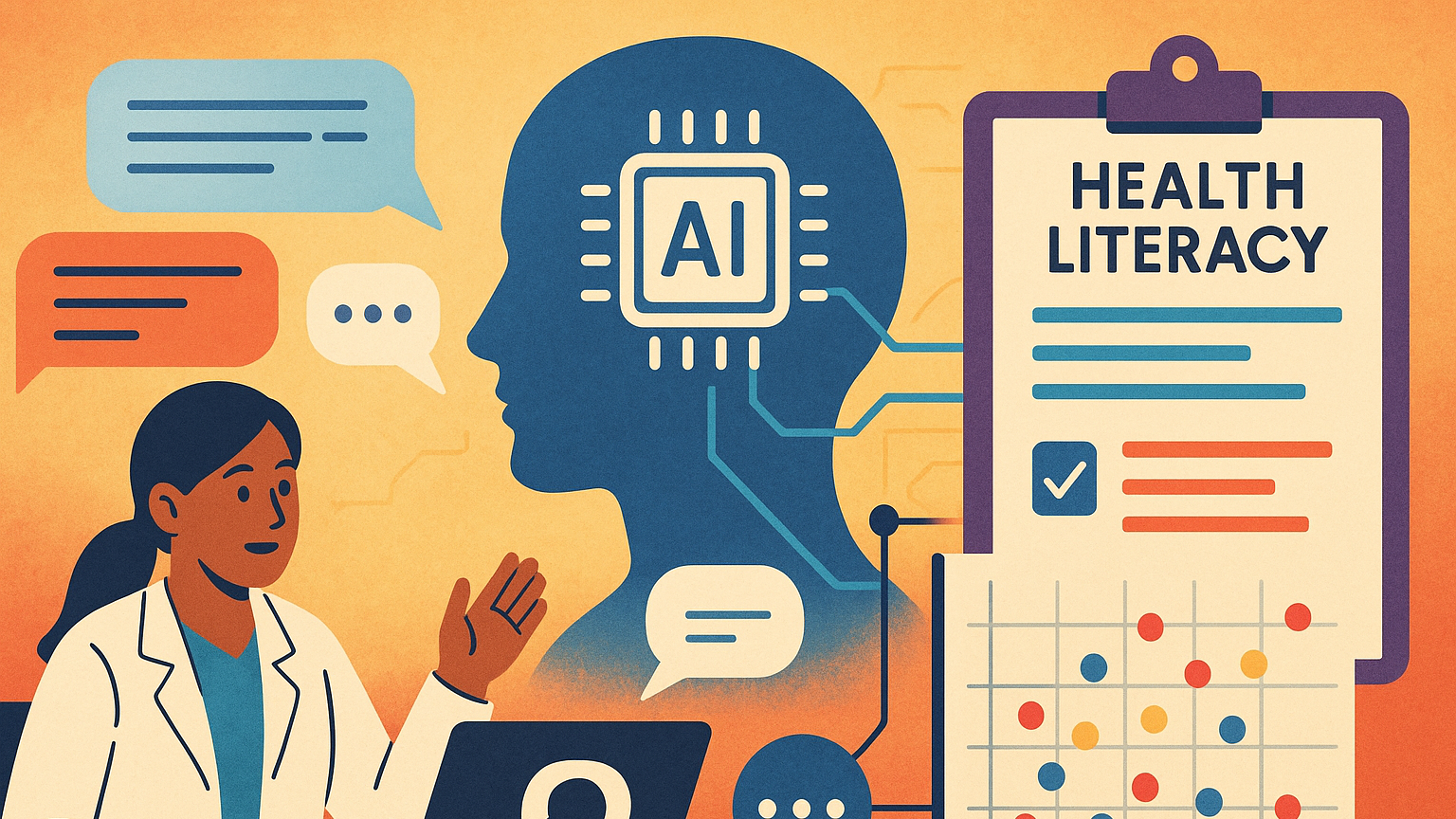
AI strategies for Health literacy assessment and adjustment in patient communication
You want your patient communication to be effective, equitable, and efficient. Health literacy is a critical determinant of outcomes: if your patients don’t understand instructions, medications, or follow-up plans, their care will suffer and your operational metrics will too. AI gives you tools to assess health literacy at scale and to adjust the content, format, and delivery of information so that patients can actually use it. This article walks you through practical AI strategies, implementation steps, evaluation metrics, and governance considerations so you can bring high-impact, patient-centered solutions into your clinical operations and patient education workflows.
Why health literacy matters for clinical operations and patient care
Health literacy affects adherence, appointment attendance, readmission risk, and patient satisfaction — all metrics you track in clinical operations. When patients don’t understand discharge instructions, medication regimens, or the reasons for follow-up, you face avoidable phone calls, emergency visits, and inefficiencies. You can use AI to identify gaps early, personalize education materials, and reduce clinician time spent repeating explanations. That means better outcomes for patients and better productivity for your teams.
How AI is changing patient communication
AI changes patient communication by automating assessment, enabling dynamic personalization, and scaling multilingual and multimodal content creation. Instead of one-size-fits-all pamphlets, you can deliver tailored explanations that match a patient’s reading level, preferred language, cultural context, and learning modality. AI also frees clinicians from repetitive tasks — summarizing visits, generating patient-friendly care plans, and monitoring comprehension — so your staff can focus on higher-value interactions.
Foundations: defining health literacy assessment with AI
You need a clear definition of health literacy for your AI work: it’s the set of skills, like reading, numeracy, and digital competency, that enable a person to find, understand, and use health information. With AI, assessment can be explicit (tests and questionnaires augmented by models) or implicit (inferred from text, chat interactions, or behavior in patient portals). Explicit assessments provide validated scores; implicit assessments let you continuously adapt communication in real time without burdening the patient.
Types of AI-driven assessment approaches
There are several AI approaches to assessing health literacy: rule-based readability measures, supervised classifiers trained on labeled examples, and embedding-based models that infer comprehension likelihood from language patterns and interaction signals. You’ll choose approaches depending on your data availability and risk tolerance. Readability indices are easy to implement but coarse, while supervised AI can capture nuance but requires labeled training data and careful validation.
Readability metrics and their limitations
Readability formulas like Flesch-Kincaid, SMOG, and Gunning Fog are simple, transparent, and useful as a first filter. You can implement them quickly to flag materials that are too complex. However, they only measure surface features (sentence length, syllable counts) and miss domain-specific vocabulary, cultural context, and the patient’s numeracy. Don’t rely on readability alone — combine it with AI models and human review for robust assessment.

Supervised machine learning and NLP classifiers
Supervised classifiers allow you to predict health literacy levels from patient writing, chat logs, or responses to prompts. Using labeled datasets where health literacy scores are known, models can learn linguistic features and markers of comprehension. You’ll typically use transformer-based architectures (like BERT variants) or gradient-boosted trees on engineered features, depending on your dataset size. These models can be incorporated into triage systems, so clinicians get an alert when a patient likely needs simplified materials.
Building an AI health literacy assessment pipeline
You want an assessment pipeline that is accurate, explainable, and respectful of privacy. A robust pipeline includes data collection and labeling, model selection and training, human-in-the-loop validation, and deployment with monitoring and governance. When you design this pipeline, focus on reproducibility and clinician oversight so that AI_augmented decisions are trustworthy and auditable.
Data collection and labeling best practices
Your models are only as good as your data. Collect a diverse set of patient communications — portal messages, chat logs, spoken encounters (with consent), and responses to comprehension checks. Labeling should use validated instruments (e.g., Brief Health Literacy Screen, REALM, TOFHLA). If you can’t collect large labeled datasets, consider expert annotation or synthetic data augmentation, but keep the provenance transparent so you can estimate generalizability.

Model selection, training, and explainability
Choose models that match your needs: simple classifiers for explainability and rapid deployment, transformer-based models for higher accuracy with larger datasets. Always prioritize explainability in clinical settings — clinicians must understand why the AI recommends simplified language or additional education. Use feature attribution methods, attention visualizations, or rule-based fallback logic so you can show rationale during care decisions.
Human-in-the-loop validation and continuous feedback
Never deploy assessment models without clinician or patient educator review. Human-in-the-loop workflows let you catch misclassifications, refine model behavior, and gather real-world feedback. Build interfaces where staff can confirm or correct AI-derived health literacy labels; feed those corrections back into retraining pipelines to reduce drift and improve fairness.
Deployment, monitoring, and model governance
Deploy models behind clear governance practices. Instrument your systems to monitor performance metrics, error rates, and distributional shifts (e.g., if patient demographics change). Set thresholds for human review, maintain versioning, and create rollback plans. You also need incident-response processes for misinformation or privacy incidents.
How AI adjusts patient communication in real time
You want AI that not only assesses but adapts — that can rewrite instructions at the right reading level, change tone to be more empathetic, or present content in a preferred language and format. This dynamic adjustment can happen at multiple touchpoints: post-visit summaries, chatbot replies, medication instructions, and consent language.
Personalization strategies for content simplification
Personalization involves mapping patient literacy profiles to appropriate content strategies. For lower literacy, use short sentences, plain language, active voice, and concrete examples. For numeracy challenges, convert percentages into absolute numbers or visual scales. AI enables you to automate these transformations at scale while preserving clinical accuracy: a model can identify medical jargon and substitute patient-friendly phrasing, passing adjustments through clinician verification when needed.

Tone, cultural competence, and empathy tuning
Your communication should feel human and culturally respectful. Use AI to adjust tone — more reassuring, less technical — and to account for cultural preferences or idioms. Fine-tune models or use prompt engineering to produce messages that align with your care culture and compliance requirements. Always validate with community representatives to avoid stereotyping or misinterpretation.
Multimodal outputs: visuals, audio, and video
Patients learn in different ways. AI can generate multimodal resources — simplified diagrams, labeled images, short explainer videos, and audio recordings — to reinforce written materials. For example, the same discharge instructions can come as a one-minute audio summary for someone with low literacy or a step-by-step illustrated guide for visual learners. Multimodal outputs increase comprehension and adherence when tailored appropriately.
Chatbots and virtual assistants: conversational assessment and adjustment
Chatbots are practical front-line tools to assess health literacy during natural conversation. You can design chat flows that subtly probe understanding (e.g., asking patients to paraphrase instructions) and adapt follow-ups based on responses. This conversational approach can reduce burden on clinicians while catching misunderstandings early.
Designing effective conversational flows
Build chatbots with layered questioning: start with simple, open prompts and follow up with clarifying questions when you detect confusion. Use short messages and confirmatory checks like teach-back prompts. Also design fallback pathways that escalate to a human when comprehension is uncertain or when the patient requests human support.
Safety, escalation, and clinician oversight
Make escalation rules explicit: when a patient expresses uncertainty, confusion, or a high-risk symptom, your bot should prompt immediate clinician review or schedule a callback. Keep clinicians in the loop by generating summaries of the conversation and highlighting comprehension concerns so your care team can intervene efficiently.

Spoken communication and ASR-based assessment
Many encounters are verbal, and assessing comprehension from spoken interactions requires automatic speech recognition (ASR) combined with NLP. ASR can transcribe encounters, and models can detect markers of misunderstanding (long pauses, repeated questions, or fragmented sentences). When you capture speech cues, you can generate prompts for clinicians to provide clarifications in real time.
Using ASR to detect confusion and teach-back opportunities
ASR combined with real-time analytics can flag moments when a patient appears confused, allowing the clinician to pause and apply teach-back techniques. For follow-up, you can create audio summaries of key points or short voice messages in the patient’s preferred language. When you use ASR, ensure robust speaker diarization and noise handling to get accurate insights.
Accuracy, privacy, and environment considerations
ASR struggles with accents, background noise, and domain-specific terms, so validate it with your patient population and tune language models accordingly. Also treat audio data as highly sensitive — apply encryption, minimal retention, and explicit consent before recording or using speech for model training.
Multilingual and cultural adaptation
You likely serve patients with diverse linguistic backgrounds. AI allows rapid translation and localization of content, but machine translation alone may miss cultural nuances and appropriate health metaphors. Invest in culturally informed adaptation and human review to ensure messages are both linguistically and culturally appropriate.
Strategies for safe translation and localization
Combine machine translation with post-editing by bilingual clinicians or professional translators familiar with medical contexts. Use glossaries of preferred translations for medical terms and involve community advisors in reviewing materials. Over time, collect feedback and refine your translation models to better reflect local usage and cultural sensitivities.
Accessibility and alternative formats
Accessibility means more than readable text. You should provide large-print documents, audio alternatives, captions, sign-language videos, and simplified graphics for cognitive accessibility. AI can auto-generate captions, produce spoken versions, and create simplified diagrams, but always include human validation to ensure clinical accuracy and avoid miscommunication.
Designing for diverse abilities and devices
Consider how patients access information: smartphones, feature phones, printouts, or in-clinic displays. Optimize content for low bandwidth and offline access where necessary. AI can help adapt content to device constraints, but your design must prioritize clarity and redundancy — the same message delivered through multiple modalities increases the odds of comprehension.
Metrics and KPIs for assessing success
You need to measure whether AI-driven adjustments actually improve understanding and outcomes. Define a balanced set of metrics that capture immediate comprehension and longer-term health impacts. These metrics will help you iterate and make the business case for scaling.
Important KPIs to track
Measure a mix of process and outcome indicators. Examples include:
- Patient comprehension rates (teach-back success or comprehension quiz scores)
- Readability scores of materials before/after adjustment
- Adherence rates to medication and follow-up appointments
- Patient satisfaction and trust scores
- Time clinicians spend on patient education
- Rates of avoidable readmissions or emergency visits
Use A/B testing and randomized pilots where possible to attribute changes to your AI interventions.

Governance, privacy, and ethical considerations
You must meet regulatory obligations like HIPAA and adhere to ethical principles around fairness and autonomy. Data minimization, consent, and transparency about AI involvement are non-negotiable. Put guardrails in place to prevent harm — for example, avoid over-simplifying risks in consent documents or replacing human judgment in urgent clinical decisions.
Mitigating bias and ensuring equitable outcomes
AI models can reflect biases in training data, which may disadvantage certain demographic groups. Test models across subgroups, monitor for disparate impacts, and apply fairness-aware techniques during training. Keep human oversight for high-stakes communications and involve diverse stakeholders in model design and evaluation.
Integrating AI into clinical workflows
You want AI to support, not disrupt, care teams. Integrate assessment and adjustment tools into existing points of care: your EHR, patient portal, or communication platforms. Make outputs actionable — generate clinician-facing prompts, editable patient summaries, and clear escalation recommendations to streamline adoption.
Designing clinician-friendly interfaces
Clinician acceptance improves when AI tools reduce workload and are easy to use. Provide concise, actionable suggestions rather than raw scores. Allow clinicians to edit AI-generated content, maintain version history, and access quick explanations for why the AI made a recommendation.
Training staff and change management
Successful implementation requires clinician buy-in, training, and ongoing support. Provide practical workshops, role-play exercises with chatbots, and reference guides on teach-back and plain-language principles. Celebrate early wins and capture feedback loops so your teams feel ownership over the new tools.
Building competence and confidence
Focus training on interpreting AI outputs, when to override suggestions, and how to document adjustments. Use case-based learning to show how AI can reduce mundane tasks and free up time for complex patient care. Peer champions can accelerate adoption by demonstrating real-world benefits.
Example prompts and templates you can use
You can prototype quickly with prompt engineering for LLMs or with template-based text transformations. Below are examples of prompts and templates you can adapt for patient-facing communication. Test them with your population and add clinician review.
- Prompt to simplify discharge instructions: “Rewrite the following discharge instructions using plain language at a 6th-grade reading level, keep medical accuracy, use short sentences, and include one numbered action list for medications and one numbered action list for follow-up steps.”
- Prompt for teach-back summary generation: “Summarize the key points of this visit in three short bullet points a patient can read aloud to confirm understanding. Include medications (name, dose, timing) and next steps.”
- Template for multilingual replies: “Translate the following patient-facing text into Spanish, then provide a back-translation into English for clinician review, and flag any idioms that may not translate directly.”
These prompts help you get started quickly, but always validate outputs with clinicians and patients.
Measuring ROI and making the business case
You need to quantify benefits to justify investment. Estimate time saved per clinician in education tasks, reductions in call volumes and readmissions, and improvements in adherence metrics that translate to cost savings. Combine quantitative measures with qualitative benefits like improved patient experience and reduced clinician burnout for a compelling business case.
Elements to include in an ROI calculation
When you build ROI models, include initial development and integration costs, ongoing maintenance, staff training, and data governance expenses. Compare these to projected savings from reduced clinician time on repetitive education, fewer adverse events, lower readmission rates, and improved throughput. Pilot projects can provide early data to refine estimates before broader rollout.
Common pitfalls and how to avoid them
There are predictable risks when introducing AI for health literacy: overreliance on machine-generated text, ignoring cultural context, insufficient validation, and lack of clinician ownership. Avoid these pitfalls by defaulting to human review for high-stakes content, involving community representatives early, and instrumenting systems for continuous evaluation.
Practical mitigation strategies
- Start with narrow, high-value use cases to limit risk.
- Keep clinicians in the loop and give them edit power.
- Use layered review workflows where AI suggests and humans approve.
- Monitor performance and patient outcomes closely after deployment.
Future trends and where to focus next
The near future will bring better multimodal understanding, continual learning systems, and more sophisticated personalization. You should watch for advances in on-device inference for privacy-preserving processing, better few-shot adaptation to local language and culture, and integration of patient-generated health data into personalization algorithms. Keep improving your data pipelines and governance frameworks so you can adopt these innovations safely.
Priorities for your roadmap
Focus first on strong assessment methods, simple but effective personalization, and clinician-friendly integrations. Build the habit of monitoring impact and iterating based on patient feedback. As your data and trust mature, expand into multimodal content and more proactive, predictive support for patients at risk of poor comprehension.
Practical implementation checklist
If you’re ready to move forward, start with a structured checklist to guide your pilot and scaling phases. Keep the checklist actionable and iterate rapidly based on measured outcomes.
- Identify a focused pilot use case (e.g., discharge summaries for heart failure patients).
- Gather representative data and label a validation set.
- Choose a lightweight model and human-in-the-loop workflow.
- Integrate into the clinician workflow and patient portal.
- Define KPIs, monitor outcomes, and collect feedback for iteration.
This sequence helps you manage risk and demonstrate value early.
Conclusion and next steps
You’re positioned to transform patient communication with AI by building systems that assess literacy, tailor content, and integrate with care workflows. Start small, keep humans in the loop, measure outcomes, and scale thoughtfully. When you do this well, you’ll improve patient understanding, reduce avoidable care variations, and free clinicians to focus on human-centered care.
